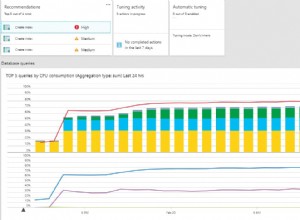Zrobiłem prosty scenariusz, który powinien Cię zacząć. Nie zawracałem sobie głowy dopracowywaniem dat, a porównania punktów końcowych mogą wymagać poprawek.
select
P_ID,
src.starttime,
endtime = case when src.starttime <> lst.starttime or lst.starttime < DATEADD(dd,-1 * @gap,GETDATE()) then lst.starttime else GETDATE() end,
frst.starttime,
lst.starttime
from @SOURCETABLE src
outer apply (select starttime = MIN(starttime) from @SOURCETABLE sub where src.p_id = sub.p_id and sub.starttime > DATEADD(dd,-1 * @gap,src.starttime)) frst
outer apply (select starttime = MAX(starttime) from @SOURCETABLE sub where src.p_id = sub.p_id and src.starttime > DATEADD(dd,-1 * @gap,sub.starttime)) lst
where src.starttime = frst.starttime
order by P_ID, src.starttime
Otrzymuję następujące wyjście, które jest trochę inne niż twoje, ale myślę, że jest w porządku:
P_ID starttime endtime starttime starttime
----------- ----------------------- ----------------------- ----------------------- -----------------------
12121 2009-03-24 07:30:00.000 2009-03-24 14:25:00.000 2009-03-24 07:30:00.000 2009-03-24 14:25:00.000
12345 2011-06-27 10:00:00.000 2011-07-21 09:00:00.000 2011-06-27 10:00:00.000 2011-07-21 09:00:00.000
12345 2011-09-21 12:00:00.000 2011-09-21 17:00:00.000 2011-09-21 12:00:00.000 2011-09-21 17:00:00.000
12345 2012-07-07 14:00:00.000 2012-07-07 14:00:00.000 2012-07-07 14:00:00.000 2012-07-07 14:00:00.000
12345 2012-08-13 13:00:00.000 2012-08-16 11:23:25.787 2012-08-13 13:00:00.000 2012-08-13 13:00:00.000
45454 2010-07-12 08:00:00.000 2010-07-12 08:00:00.000 2010-07-12 08:00:00.000 2010-07-12 08:00:00.000
98765 2012-04-13 10:00:00.000 2012-04-26 16:00:00.000 2012-04-13 10:00:00.000 2012-04-26 16:00:00.000
Ostatnie dwie kolumny wyjściowe są wynikami outer apply sekcje i służą tylko do debugowania.
Jest to oparte na następującej konfiguracji:
declare @gap int
set @gap = 30
set dateformat dmy
-----P_ID----|----starttime----
declare @SOURCETABLE table (P_ID int, starttime datetime)
insert @SourceTable values
(12121,'24-03-2009 7:30'),
(12121,'24-03-2009 14:25'),
(12345,'27-06-2011 10:00'),
(12345,'27-06-2011 10:30'),
(12345,'28-06-2011 11:00'),
(98765,'13-04-2012 10:00'),
(12345,'21-07-2011 9:00'),
(12345,'21-09-2011 12:00'),
(45454,'12-07-2010 8:00'),
(12345,'21-09-2011 17:00'),
(98765,'26-04-2012 16:00'),
(12345,'07-07-2012 14:00'),
(12345,'13-08-2012 13:00')
AKTUALIZACJA:Niewielkie przemyślenie. Teraz używa CTE do obliczenia odstępów do przodu i do tyłu od każdego elementu, a następnie agreguje je:
--Get the gap between each starttime and the next and prev (use 999 to indicate non-closed intervals)
;WITH CTE_Gaps As (
select
p_id,
src.starttime,
nextgap = coalesce(DATEDIFF(dd,src.starttime,nxt.starttime),999), --Gap to the next entry
prevgap = coalesce(DATEDIFF(dd,prv.starttime,src.starttime),999), --Gap to the previous entry
isold = case when DATEDIFF(dd,src.starttime,getdate()) > @gap then 1 else 0 end --Is starttime more than gap days ago?
from
@SOURCETABLE src
cross apply (select starttime = MIN(starttime) from @SOURCETABLE sub where src.p_id = sub.p_id and sub.starttime > src.starttime) nxt
cross apply (select starttime = max(starttime) from @SOURCETABLE sub where src.p_id = sub.p_id and sub.starttime < src.starttime) prv
)
--select * from CTE_Gaps
select
p_id,
starttime = min(gap.starttime),
endtime = nxt.starttime
from
CTE_Gaps gap
--Find the next starttime where its gap to the next > @gap
cross apply (select starttime = MIN(sub.starttime) from CTE_Gaps sub where gap.p_id = sub.p_id and sub.starttime >= gap.starttime and sub.nextgap > @gap) nxt
group by P_ID, nxt.starttime
order by P_ID, nxt.starttime




